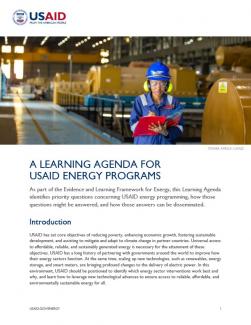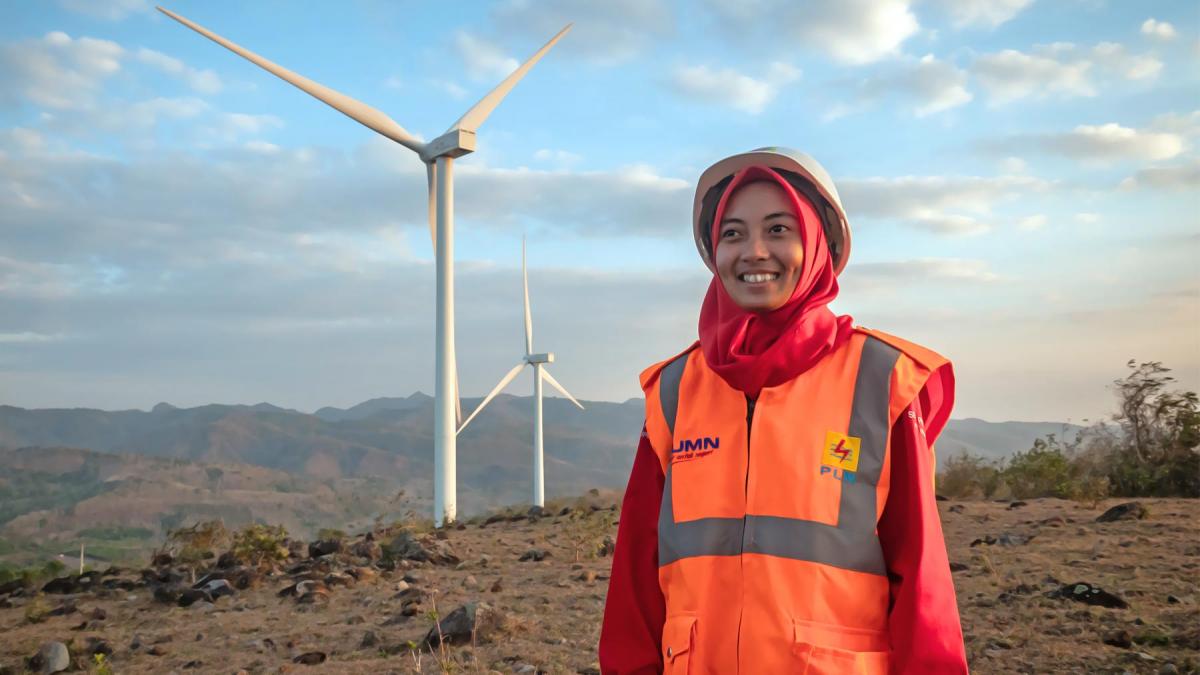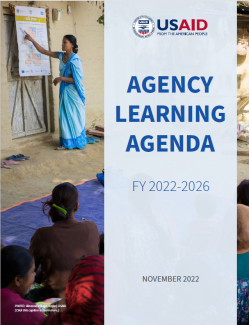As part of the Evidence and Learning Framework for Energy, this Learning Agenda identifies priority questions concerning USAID energy programming, how those questions might be answered, and how those answers can be disseminated.
USAID has set core objectives of reducing poverty, enhancing economic growth, fostering sustainable development, and assisting to mitigate and adapt to climate change in partner countries. Universal access to affordable, reliable, and sustainably generated energy is necessary for the attainment of these objectives. USAID has a long history of partnering with governments around the world to improve how their energy sectors function. At the same time, scaling up new technologies, such as renewables, energy storage, and smart meters, are bringing profound changes to the delivery of electric power. In this environment, USAID should be positioned to identify which energy sector interventions work best and why, and learn how to leverage new technological advances to ensure access to reliable, affordable, and environmentally sustainable energy for all.
The Purpose of the Learning Agenda
To assist in achieving USAID objectives, the Energy Division within USAID’s Center for Environment, Energy, and Infrastructure is leading the creation of a Learning Agenda for USAID Energy Programs. This is one piece of a larger Evidence and Learning Framework for Energy (the Framework) that will help USAID headquarters, USAID Missions, implementers, and beneficiaries access informational resources to more effectively select, design, implement, and evaluate energy programs. The Framework will serve to collect and synthesize what is known about effective energy programs, identify challenges and priority questions concerning what is not known, and provide answers to those questions.
This Learning Agenda for USAID Energy Programs lays out priority questions identified by USAID concerning energy programming. It outlines how those questions might be answered and how those answers can be disseminated.
Developing the Learning Agenda
To compile a list of priority questions about effective energy programming, the team writing the Learning Agenda interviewed stakeholders engaged in energy programming, conducted an online survey of those stakeholders, and organized three workshops to discuss knowledge gaps and priority questions in energy programming. The team also reviewed past evaluations.
Interviews
The Learning Agenda team interviewed 30 energy program stakeholders, six of whom were implementers and the rest from USAID. Interviewees proposed priority questions, many of which focused on how to improve monitoring and evaluation processes and other procedures.
Interview questions on programs included:
- What has worked and what has not worked in energy sector programming?
- How do we better define success for energy program interventions and measure progress?
- What preconditions are needed to make energy programs successful?
Interviewees also raised several issues around current learning efforts and supporting practices, including:
- Program logic models are not well-articulated, and goals are not always tightly linked to activities
- Programs lack mechanisms to demonstrate relationships between energy sector outcomes and upstream technical assistance and policy interventions that tend to be a focus of energy programs
- Success stories may not be tied to data or capture the “whys” and “hows” that produced the results that were achieved
- Evaluations of energy sector programs were criticized for being ad hoc, pro forma, too long to be digestible, and too late to impact implementation, among other shortcomings
- USAID energy programs lack mechanisms to track project outcomes after the project ends
- Monitoring focuses heavily on reporting and administrative requirements as opposed to learning
- Resources are not prioritized for learning or evaluations
Document Review
The team first reviewed USAID documents on learning agendas, especially those related to energy programs. Documents included the Foundations for Evidence-based Policymaking Act, USAID’s Agency Learning Agenda, examples of other learning agendas from within USAID and from other agencies, blog postings, guidelines for developing learning questions, and several learning tools. The team also reviewed USAID guidance pertaining to monitoring and evaluations.
To understand key areas of focus for USAID energy programs, the team reviewed statements of work and implementation plans for several recent USAID energy programs and focused on the descriptions of theories of change and links between theories of change and program goals and activities.
Finally, to better understand current learning efforts, especially monitoring and evaluation, the team reviewed monitoring plans from the statements of work of energy programs. After extracting a list of all past and proposed evaluations of energy programs from the Evaluation Registry, the team reviewed the 11 most recent evaluations.
Survey
In October 2021, the Energy Division conducted a survey of USAID personnel who have engaged in energy programs. The purpose of the survey was to help the Division prioritize energy program goals and areas of intervention by gathering information from USAID energy stakeholders. The survey queried respondents about which goals for energy programs they considered most important, which areas of energy programming they thought were most likely to be incorporated into energy programming in the coming decade, and what approaches are most likely to be used in energy programming over the next ten years. Thirty-nine USAID personnel participated in the survey.
Respondents said the most important goals for energy programming are “Operationally efficient, financially viable generation, transmission, and distribution systems,” followed by “Environmentally sustainable power systems that support the transition to low-carbon economies in a socially inclusive manner.” The areas they said are most likely to be included in energy programming over the next decade are “Mobilizing finance for investment in the electric power sector,” “Grid flexibility and integration of renewables,” and “Electric power sector policy, legal, and regulatory frameworks.” Respondents said that the approaches used most often in energy programming have been technical studies and analyses, stakeholder convenings and coordination, and knowledge development and dissemination.
Workshops
Three 90-minute workshops were organized in December 2021 to which all USAID staff with an interest in energy programming were invited. The workshops were scheduled to enable personnel from USAID Missions throughout the world to attend at a time that overlapped with their normal working hours. Each workshop was split into two parts. During the first part, participants were asked to reflect on activities and approaches within the technical area that they had found to be especially effective. The discussion included the preconditions for the activity or approach to be successful. In the second part of the session, participants discussed the most important challenges they face and what knowledge they would need to address those challenges effectively. The workshops culminated in writing a set of priority questions to be answered by the Framework. The workshops covered all the energy technical areas listed in the following section except Enabling Incentives for Renewables Including Competitive Procurement and Equity, Justice, and Inclusion in the Energy Sector. The choice of technical areas to be covered in the workshops was dictated by the responses to the survey. Workshop participants numbered 35, of which 18 were located at Missions and 17 in Washington.
The Learning Agenda
The Learning Agenda for Energy Programming defines strategic learning areas that are of high importance and broad applicability to USAID energy programs, while also developing an organizational framework that allows for the identification and prioritization of new learning resources. The Learning Agenda team, in conjunction with stakeholders within the activities above, developed five priority questions to form the backbone of the Learning Agenda.
Priority Learning Questions
- What are the most effective strategies for USAID to support improved operational and financial performance in the energy sector?
- How can USAID energy programs most effectively support the transition to low-carbon economies?
- How can USAID most effectively help expand access to reliable electricity?
- What are the most effective means for USAID to promote an inclusive and equitable energy sector?
- What are the most effective approaches for USAID to help host country governments to develop strong governance, regulatory, and policy frameworks for the energy sector?
Key Technical Areas for the Energy Sector
- Electric Power Sector Governance
- Power Sector Reform, Restructuring, and Markets
- Energy Sector Planning
- Utility Management and Financial Performance
- Utility Technical Performance and Grid Modernization
- Regional or Cross-border Power Trade
- Access to Reliable Electricity
- Enablers for Renewables Development
- Demand-side Energy Efficiency
- Emissions Reduction in Industry
- Emissions Reduction in Transportation
- Mobilization of Finance for Investment in the Electric Power Sector
- Equity, Justice, and Inclusion in the Energy Sector
Incorporating What We Know
USAID has a long history of implementing programs designed to achieve the goals of improved sector performance, low-carbon development, expanded energy access, equity and inclusion, and strong sector governance. Experience with and evaluations of those programs have generated some answers to the priority learning questions. However, gaps remain concerning which programs are most effective and why.
Evaluations and experience with frequently implemented technical areas have provided a first-level answer to the priority learning questions described above. The Learning Agenda, therefore, centers on three areas of exploration:
- Learning around the effectiveness of specific approaches and interventions in the technical areas
- Evidence that supports the ways the technical areas can help achieve the goals reflected in the priority learning questions
- Identification of new areas and approaches that are currently not commonly implemented in USAID energy sector programs
Importantly, the five priority questions will contribute to USAID’s Agency Learning Agenda, namely the agency-wide learning question on climate which states, “How can USAID best engage global actors, partner countries, and local leaders to mitigate the climate crisis and support equitable adaptation to its impacts?” The Agency Learning Agenda will bring together evidence from the Energy Learning Agenda with learning from across USAID’s sectors and geographies to support evidence-informed decision-making as USAID furthers policy priority areas.
Implementing the Learning Agenda
The priority questions and technical areas described above provide a structure for organizing learning in the energy sector and help prioritize future learning efforts.
To begin to identify specific knowledge gaps and strategies for addressing them, USAID held a series of working sessions with Energy Division staff which focused on identifying gaps in knowledge and resources around a subset of key technical areas:
- Demand-side Energy Efficiency
- Equity, Justice, and Inclusion in the Energy Sector
- Energy Sector Planning
- Utility Technical Performance and Grid Modernization (including flexibility, technology upgrades, cybersecurity, integration of renewables)
These working sessions illustrated several key points:
- USAID staff were able to point to gaps in resources or knowledge in each of the technical areas which, if filled, would provide opportunities to enhance the Agency’s effectiveness;
- There are differences in the gaps in resources and knowledge for each technical area depending on USAID’s past experience in that area;
- The decentralized nature of USAID’s energy sector programming—with a strong emphasis on bilateral interventions—creates some obstacles to a more centralized process of collecting and disseminating learning resources in different forms, especially when information is not written down;
- In most technical areas, USAID and other stakeholders have substantial amounts of existing information resources, but those resources may not be readily available or familiar to the majority of USAID staff; and
- There are gaps in linkages between different resources which may present challenges in using existing information in a practical manner.
Learning Activity Areas
Based on these workshops, the Energy Division has identified three learning activity areas to be implemented over the next five years. These activity areas will fill gaps in knowledge and make existing evidence and information more accessible to USAID staff and more easily applied to programming. Efforts should detail when and how information may be applied throughout the program cycle (project or activity design, implementation, and assessment), and create tools and products that are relevant and accessible at each stage of programming.
Cross-Cutting Learning Activities
These activities span the 13 technical areas listed above and are likely to involve areas of learning that are common across many technical areas. A priority activity will be to develop a site within USAID’s intranet that can serve as an internal resource library for USAID staff. This site may be used to host, for instance, a library of energy evaluations or a series of logic models that explain the programmatic interventions known to address the priority learning questions. In addition, the Energy Division will identify opportunities to update its approach to engagement with USAID Missions and Operating Units to support improved tracking and information-sharing on bilateral and regional programs in support of the Learning Agenda.
Foundational Learning Activities
We expect each technical area will require a foundational set of activities related to identifying and curating existing resources. USAID has already generated a great deal of knowledge around the technical areas listed above, but resources are not always easily found, accessed, or shared. A concerted effort will be made to begin to compile these resources within the resource library. In addition, the Energy Division will establish and maintain a running list of active and recent USAID activities which include components relevant to each technical area.
Enhanced Learning Activities
The Energy Division recently completed workshops on four of the technical areas listed above (Energy Efficiency; Energy Planning; Equity, Justice, and Inclusion in the Energy Sector; and Utility Technical Performance) to take stock of gaps in existing resources and brainstorm new ways of filling these gaps. These four technical areas will serve as focal areas to pilot new learning approaches and seek to improve the evidence base for what works and what doesn’t in these technical areas.



